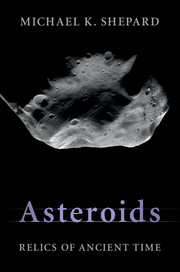Book contents
- Frontmatter
- Dedication
- Contents
- Preface
- Acknowledgements
- Brief list of asteroid and meteorite terms
- 1 It's a small world
- 2 A night at the zoo
- 3 It came from outer space
- 4 A day at the museum
- 5 The gambler's fallacy
- 6 Remembrance of things past
- 7 The ties that bind
- 8 Terra incognita
- 9 To your scattered bodies go
- 10 Scouts, sappers, and miners
- Glossary
- Bibliography
- Index
- References
1 - It's a small world
Published online by Cambridge University Press: 05 May 2015
- Frontmatter
- Dedication
- Contents
- Preface
- Acknowledgements
- Brief list of asteroid and meteorite terms
- 1 It's a small world
- 2 A night at the zoo
- 3 It came from outer space
- 4 A day at the museum
- 5 The gambler's fallacy
- 6 Remembrance of things past
- 7 The ties that bind
- 8 Terra incognita
- 9 To your scattered bodies go
- 10 Scouts, sappers, and miners
- Glossary
- Bibliography
- Index
- References
Summary
Then I felt like some watcher of the skies
When a new planet swims into his ken;
John Keats, On first looking into Chapman's Homer
TRAIN STATION SIX
On the evening of October 6, 2008, Richard Kowalski was monitoring the search results of hundreds of images he and others routinely take each clear night with the 1.5 m Mt. Lemmon telescope. It is one of three telescopes used for the Catalina Sky Survey, an effort funded by NASA to discover new asteroids and comets. As on many other nights, a faint speck in the images, one of thousands, caught his attention – a new asteroid. After checking to see that it was not already known, it was dutifully given the cryptic provisional designation 8TA9D60 and reported to the Minor Planet Center in Cambridge, Massachusetts, the clearinghouse for all new asteroid and comet discoveries. Other observatories in Arizona and Australia were notified and quickly observed it. Dozens of new images were taken, giving enough information to calculate orbital elements and announce the discovery through a Minor Planet Electronic Circular. All of this happened within eight hours of the initial discovery and, by then, the object had a new name – 2008 TC3. Why the rush? Preliminary orbital calculations at the Minor Planet Center showed a 100% chance of impact in less than twelve hours.
In the eight hours between discovery and announcement, astronomer Steve Chesley at NASA's Jet Propulsion Laboratory (JPL) had been flagged and confirmed the initial assessment: the orbit of 2008 TC3 would intersect the Earth on 2008 Oct 07 02:46 UTC (Universal Time), less than twelve hours from the announcement, with an impact point over northern Sudan. In a stunning display of rapid international collaboration by professional and amateur astronomers around the world, hundreds of additional observations were made in the remaining hours and, one hour prior to impact, Paul Chodas – a colleague of Chesley's at JPL – reported a refined atmospheric entry time of 2008 Oct 07 02:44:28 UTC ± 15 seconds, with an impact time of 02:46:20 UTC ± 40 seconds.
Information
- Type
- Chapter
- Information
- AsteroidsRelics of Ancient Time, pp. 1 - 34Publisher: Cambridge University PressPrint publication year: 2015
